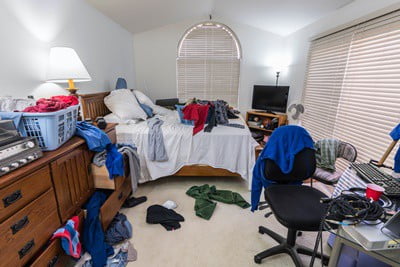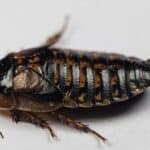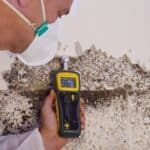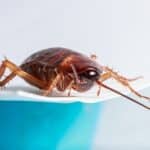A factor that many people overlook when choosing an apartment is cockroaches. Trying to find cockroaches in an apartment that you don’t live in yet may seem far too difficult, but that’s not the case. Cockroaches leave behind many signs that enable you to determine if they’re hiding away somewhere.
To tell if an apartment has cockroaches, look for feces, shed skins, smear marks, and dead roaches. If there’s a large infestation, you can smell cockroaches due to their oily, musty odor. You can find cockroaches in appliance motors, kitchen and bathroom sinks, near drains and pipes, behind cookers, and inside cabinet drawers.
The landlord must ensure the rental property complies with health and safety codes in the U.S. That includes clearing the apartment of any cockroaches before the tenant moves in. If you run into a problem, talk to your landlord and document all signs of an infestation, and contact the health department (if necessary).
How Common are Roaches in Apartments?
According to the Journal of Economic Entomology, cockroaches are more common in apartments than houses.
With more people living in an area, there’s more food, waste, and garbage. If cockroaches have trouble finding food in one apartment, the next place is nearby.
Using traps and bait is likely to cause cockroaches to flee to another apartment. Once your apartment is clear of traps or residual pesticides, the infestation can return. All tenants need to work together to get rid of cockroaches, which normally require the landlord’s involvement.
If a neighbor has a dirty, cluttered house, there are likely to be cockroaches. When one apartment gets overcrowded or runs low on resources, some cockroaches will seek homes in different apartments.
One apartment is only a wall or ventilation duct away from another apartment.

Does An Apartment Have Roaches?
Some landlords may not know or tell the truth about an apartment’s infestation status. They want you to sign the lease. That places the burden on you to detect cockroaches and decline to rent the apartment.
Check for the following signs of cockroaches in an apartment:
Egg Casings
Females produce egg casings called ootheca. These are used to carry their unhatched eggs.
The ootheca will be hidden away in a safe and secure place. If you find an ootheca in broad daylight, the apartment is already infested.
Cockroach ootheca are the same color as roaches themselves. They are oval in shape, but most will be torn open from when the nymphs hatched.
Exoskeletons
Cockroaches grow by molting. This happens when they shed their exoskeleton to make room for a bigger and longer body. Nymphs molt an average of 6 times until they reach a final molt and become adults.
Shed exoskeletons are thin and similar in color to the average cockroach. Just like the ootheca, you should have no problem identifying them at a glance. If you find a single exoskeleton, there will be more.
Cockroaches
When people check out apartments, they normally visit during the day. Seeing a cockroach during daylight is a sign of a severe problem. If they are forced to scavenge during risky hours, there are countless more still in hiding.
According to Chulalongkorn University, cockroaches have specific feeding times. They’re most active between the hours of 5 P.M. and 6 A.M. They leave their nests and hunt for food during these times.
Poop
Cockroach feces are as small as coffee grounds and black pepper. Cockroaches defecate as they go about their lives. Cockroaches navigate via routes they know are secure, using these paths to travel around the apartment.
Smell
A single cockroach won’t have a strong odor. However, hundreds of roaches have an odor that can be easily detected.
Cockroaches have an oily, musky smell because they are constantly releasing pheromones. These are emitted when they die, communicate with each other, and during mating.
Where to Look For Cockroaches in An Apartment
Cockroaches like damp, dark, and secure cracks and crevices. When apartment hunting, look for cockroaches in:
- Kitchen and bathroom sinks
- Bathroom cabinets
- Kitchen drawers and cabinets
- Pipes
- Shower drains
- Water heaters
- Air conditioners
Renting an Apartment with Roaches
If you see the above signs in an apartment, assume that it’s infested.
Even if the landlord tells you that the apartment was recently fumigated, don’t automatically trust their word.
Check the Lease
Ensure that the lease states that the landlord is renting the apartment to you in “habitable condition.”
This should be in every standard lease since it’s required by law.
Providing a habitable place to live is a basic requirement. However, there could be many loopholes written among the legal jargon. This could protect the landlord in court, should they ever get sued.
Before signing, go over the lease at least once with the landlord. This will clear up any doubts.
You can also ask what the plan of action is, should you ever find cockroaches after moving in.
Take Pictures
Take date-stamped pictures of the apartment before you move in. Most landlords do this on their own, but it’s sensible to have your own pictures.
If there are cockroach eggs, exoskeletons, or other forms of proof, you need pictures and documentation. A landlord is unlikely to photograph that during their walkthrough.
Aside from verifying the infestation, this safeguards you from liability. Cockroaches can damage an apartment. Their feces may stain walls and floors. They can also destroy insulation, wood, and furniture by biting them.
When it’s time to move out, you need to prove that you weren’t the one who caused the damage.
Just Signed a Lease And Found Roaches
If you’ve moved into a new apartment with cockroaches, you can take legal action. If you signed a lease stating that the apartment is habitable, the presence of cockroaches contravenes that requirement.
You don’t have to buy pest control products because the landlord wasn’t upfront (or didn’t know) about the apartment’s conditions. However, terminating a lease early often comes with a penalty.
Here’s what you can do instead:
Communicate with the Landlord
Talk with the landlord and explain that the apartment has a cockroach infestation. If the landlord agrees to get rid of the cockroaches, they have a defined number of days to fix the issue.
The timeline depends on the state and the terms of the lease. Call your local health inspector if the landlord doesn’t resolve the issue within the timeframe provided.
If the landlord explains that you need to handle the infestation, you can call your local health department. They’ll let you know whether the apartment is in livable condition. Afterward, they may:
- Tell the landlord to handle the infestation within a certain timeframe
- Shut the building down

Know Your Rights
Before calling the health department, make sure you know all your rights by checking your state’s civil code.
If the landlord disputes the claim that the lease has been violated, your rights as a tenant will be crucial. It’s illegal to knowingly rent someone an apartment with cockroaches as it’s a health risk.
Roaches in Apartment Law
In the United States, landlords are responsible for ensuring their property is in habitable condition.
The apartment shouldn’t contain anything that can put a tenant at risk of injury or health deterioration. Cockroaches trigger allergies and spread diseases, so they are definitely a health risk.
Every state has different rules about renting apartments with cockroaches. Checking your state’s civil code and calling your local health inspector will enable you to understand your legal rights.
What the Law Says About Cockroaches in Apartments
Landlords must ensure that an apartment is roach-free before they rent it out.
If there were cockroaches before you moved in, it is up to the landlord to pay for pest control. Depending on the state, the landlord has a few days to a few weeks to resolve the cockroach problem. If the landlord fails to do so, a penalty will be given by the local health department.
In some cases, you may bring up the infestation to your landlord, and your claim will be disputed. Here, you’ll need to contact the local health authorities or get legal assistance. This is where the pictures you took are so useful.
If the cockroach problem was the landlord’s fault, there are two ways to go about paying for the extermination methods:
- The landlord pays for it out of personal or business funds
- The tenant pays, but this is subtracted from the rent that must be paid
It varies by state, but the second option may not be valid unless you meet specific requirements. For example, in Missouri, tenants can only get rent deducted to pay for damages if they have:
- Lived on the property for at least 6 months
- Paid all rent owed
- Given their landlord at least 14 days to respond to the notice
In some cases, it may be determined that cockroaches were present because of your actions. If it’s because of negligence, the tenant must pay for pest control.
This factor is included in most leases since it protects the landlord from liability. Because of this, it’s always wise to thoroughly document and photograph the apartment once you arrive.




